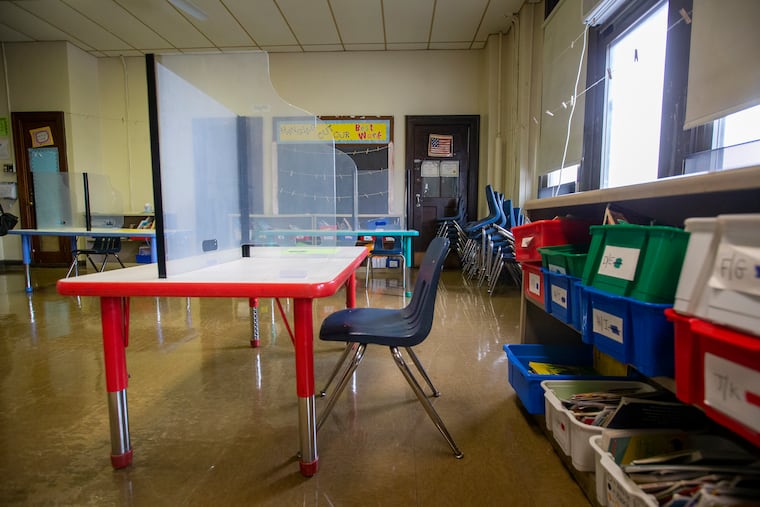CDC gives new road map for schools without requiring schools to reopen
Citing a growing body of science on the virus, officials with the Centers for Disease Control and Prevention outlined strategies for schools, in particular universal masking and social distancing.

President Biden’s administration on Friday weighed in for the first time with guidelines for reopening schools amid the pandemic, providing a road map for local officials navigating the fraught debate on how to return students to classrooms safely.
Citing a growing body of science on the virus and data from schools in the U.S. and Europe that had reopened, officials with the Centers for Disease Control and Prevention outlined key strategies, in particular universal masking and adherence to social distancing. The guidance also ties reopening recommendations to the prevalence of the coronavirus in a school’s community.
“The safest way to open schools is to ensure that there is as little disease as possible in the community,” said CDC Director Rochelle Walensky. Even so, she said, schools can open for some in-person instruction at high levels of community transmission, provided they take necessary steps to mitigate spread of the virus.
The guidance from the Democratic administration — which is not a mandate — appears unlikely to resolve the ongoing disagreement in many communities among school leaders, teachers’ unions, and different factions of parents.
In Pennsylvania, state and county authorities have issued their own guidelines, and schools in the Philadelphia region have taken different approaches, with students in some communities attending school in person five days a week and others offering only virtual instruction.
Though Biden has pledged to reopen most K-8 schools within the first 100 days of his administration, officials said this week that the president’s commitment referred to in-person teaching “at least one day a week.”
Walensky on Friday acknowledged the role of local decision-making in reopening schools, and said returning to classrooms “must be based on a thorough review of what the science tells us works, and an understanding of the lived experiences, challenges, and perspectives of teachers and school staff, parents, and students.”
The guidance outlines five strategies officials described as key for a safe reopening of school, in particular universal masking and social distancing. The agency recommended that schools in areas with high levels of community transmission maintain six feet of spacing between students, and opt for hybrid in-person and virtual instruction or reduced in-person attendance rather than full reopenings.
A number of Philadelphia-area schools have been considering whether to reopen fully, in some cases by reducing spacing between students. The Radnor School District, for instance, announced Thursday that it would offer full-time in-person instruction to its youngest students later this month, a move that involves reducing its six-foot distance to four feet.
“Those districts may have to think twice now about whether that is a safe thing to do,” said Chris Lilienthal, a spokesperson for the Pennsylvania State Education Association, the state’s largest teachers’ union. He called the guideline “good news from the PSEA’s perspective.” Steve Baker, a spokesperson for the New Jersey Education Association, said “it was refreshing to hear the CDC keep safety at the forefront.”
In Bucks County, where the health department has endorsed three feet as a minimum in schools, some said the guidance likely wouldn’t cause any change in their approach.
“Don’t mess with what’s working,” said Bill Harner, superintendent of the Quakertown Community School District, which brought students back five days a week in the fall. Harner said the district has spaced students four-and-a-half feet apart and had “not one proven case” of in-school spread.
In deciding how to return children to classrooms, “every community, I believe, is unique,” Harner said.
» READ MORE: As schools seek to reopen, here’s what local data say about in-person classes and COVID-19
Walensky said the CDC was not requiring schools that were currently open to close, but providing “mitigation strategies we know work.”
While still leaving decisions to local authorities, the new guidelines are “more prescriptive” than the guidance from former President Donald Trump’s administration, Walensky said. The key strategies for schools also include hand washing, cleaning, and contact tracing.
Walensky, who has said teachers do not need to be vaccinated for schools to reopen safely, described inoculation as “an additional layer of protection that can be added.”
“We strongly encourage states to prioritize teachers and other school staff to get vaccinated,” Walensky said.
Most educators in the region aren’t yet eligible for vaccination. Gov. Tom Wolf’s administration said Friday it did not plan to move teachers into the state’s first priority phase for vaccination; it’s unclear when the state will move into the next phase, which included educators and other essential workers.
Another way to add protection is improving ventilation, Walensky said, “such as by opening windows and doors when possible.”
» READ MORE: https://www.inquirer.com/education/philadephia-school-district-reopening-teachers-union-20210211.html
“It’s very hard to interpret the science of safe reopening in the context of ventilation,” Walensky said. “That said, we know that respiratory viruses thrive when there’s poor ventilation and we very much advocate for another layer of mitigation to be improved ventilation.”
In Philadelphia — where school ventilation problems have spurred a standoff between the teachers’ union and district over reopening — Jerry Jordan, president of the Philadelphia Federation of Teachers, said the guidance reinforced the union’s position that ventilation was “a key metric for mitigation which is why we have been fighting against an unsafe reopening of buildings.”
Superintendent William R. Hite Jr. said the district had implemented “multiple layers of safety measures that are already included in today’s recommendations from the CDC.” He also said the district had incurred $65 million in COVID-19 related costs and was “still facing fiscal uncertainties.”
Biden’s administration has been pushing for billions in relief funding for schools. A bill advanced by House Democrats this week would give $130 billion to K-12 schools, including to repair ventilation systems and buy protective equipment.
Staff writers Melanie Burney and Erin McCarthy contributed to this article.